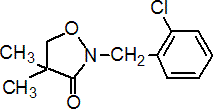|
clomazone
Herbicide
HRAC F3 WSSA 13; isoxazolidinone

NOMENCLATURE
Common name clomazone (BSI, ANSI, draft E-ISO, (f) draft F-ISO)
IUPAC name 2-(2-chlorobenzyl)-4,4-dimethyl-1,2-oxazolidin-3-one; 2-(2-chlorobenzyl)-4,4-dimethylisoxazolidin-3-one
Chemical Abstracts name 2-[(2-chlorophenyl)methyl]-4,4-dimethyl-3-isoxazolidinone
Other names dimethazone* CAS RN [81777-89-1] Development codes FMC 57 020
PHYSICAL CHEMISTRY
Mol. wt. 239.7 M.f. C12H14ClNO2 Form Clear, colourless to light brown, viscous liquid. M.p. 25 ºC B.p. 275 ºC V.p. 19.2 mPa (25 ºC) KOW logP = 2.5 Henry 4.19 ´ 10-3 Pa m3 mol-1 S.g./density 1.192 (20 ºC) Solubility In water 1.1 g/l. Miscible with acetone, acetonitrile, chloroform, cyclohexanone, dichloromethane, methanol, toluene, heptane, dimethylformamide. Stability Stable at ambient temperatures for at least 2 y; stable at 50 ºC for at least 3 mo. In sunlight, DT50 >30 d in aqueous solution. F.p. 70-75 ºC (closed cup)
COMMERCIALISATION
History Herbicide introduced by FMC Corp. Patents US 4405357 Manufacturers FMC; Sannong
APPLICATIONS
Biochemistry Inhibits carotenoid biosynthesis; target enzyme not known. Mode of action Selective herbicide, absorbed by the roots and shoots and translocated upward. Susceptible species emerge but are devoid of pigmentation. Uses Control of broad-leaved and grass weeds in soya beans, peas, maize, oilseed rape, sugar cane, cassava, pumpkins, and tobacco. Applied pre-emergence or pre-plant incorporated. Phytotoxicity Foliar contact or vapours may cause visual symptoms of chlorosis to nearby sensitive plants. Formulation types CS; EC; WP. Compatibility Compatible with many other herbicides, e.g. metribuzin, linuron, chloramben, alachlor, trifluralin, pendimethalin, metolachlor, oryzalin or ethalfluralin. Selected products: 'Command' (FMC); 'Kalif' (Makhteshim-Agan); mixtures: 'Commence' (+ trifluralin) (FMC); 'Brasan' (+ dimethachlor) (Syngenta)
OTHER PRODUCTS
'Centium' (FMC); 'Cirrus' (FMC); 'Gamit' (FMC) mixtures: 'Authority One-Pass' (+ sulfentrazone) (FMC); 'Command Cotton' (+ fluometuron) (FMC); 'Command Xtra' (+ sulfentrazone) (FMC); 'Galaxy' (+ pendimethalin) (FMC); 'RiceMax' (+ propanil) (FMC, Riceco); 'Centaure' (+ linuron+ trifluralin) (Dow AgroSciences); 'Nimbus' (+ metazachlor) (BASF)
ANALYSIS
Product by glc with FID or hplc with u.v. detection. Details and residue methods reviewed (A. W. Chen in Comp. Anal. Profiles, Chapt. 6).
MAMMALIAN TOXICOLOGY
Oral Acute oral LD50 for male rats 2077, female rats 1369 mg/kg. Skin and eye Acute percutaneous LD50 for rabbits >2000 mg/kg. Practically non-irritating to eyes (rabbits). Inhalation LC50 (4 h) for rats 4.8 mg/l. NOEL (2 y) for rats 4.3 mg/kg daily. ADI 0.043 mg/kg (proposed). Toxicity class WHO (a.i.) II; EPA (formulation) III
ECOTOXICOLOGY
Birds Acute oral LD50 for bobwhite quail and mallard ducks >2510 mg/kg. LC50 (8 d) for bobwhite quail and mallard ducks >5620 ppm. Fish LC50 (96 h) for bluegill sunfish 34, Atlantic silverside 6.26, rainbow trout 19 mg/l. Daphnia LC50 (48 h) 5.2 mg/l. Algae EC50 (48 h) 2.10 mg/l. Other aquatic spp. LC50 for pink shrimp 8.9, eastern oyster 5.3 mg/l. Worms LC50 (14 d) for Eisenia foetida 156 mg/kg.
ENVIRONMENTAL FATE
Soil/Environment DT50 in soil c. 30-135 d. Koc 150-562, suggesting clomazone would be mobile in soil; however, in field trials it was found not to leach beyond the top 10 cm of soil (J. Rosenwald et al., Proc. 9th IUPAC Int. Congr. Pestic. Chem., London, 1998, 6A-006).
|